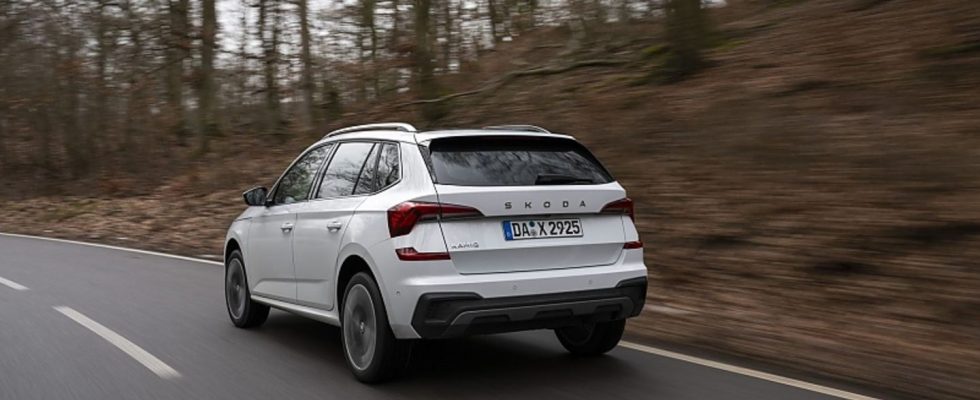Driving report: Skoda Kamiq 1.0 TSI MY 2024
Small but mighty
Skoda Kamiq MY 2024
© press-inform – the press office
Skoda refreshes the Kamiq. In addition to marginal optical retouching, the Czech VW subsidiary is upgrading the infotainment; LED matrix light is available on request and the more powerful of the two 1.0-liter TSI engines is receiving an injection of horsepower.
Someone else says that nothing works these days without an electric motor. The Skoda Kamiq has only been on the market since 2019 and has become the Czech car manufacturer’s number two during this period with 351,200 units sold. And this despite the conventional drive with an internal combustion engine. For the sake of completeness: Number one is of course the Octavia. It’s no big surprise that the small SUV hits customers’ nerves, as this type of vehicle is particularly popular in Germany. Would you like some evidence? So far, around 58,000 drivers between Garmisch and Flensburg have chosen the Skoda Kamiq. This means that Germany even outpaces the home of the Czech SUV by around 17,000 units.
Skoda is also playing its usual trump card with the facelift of the Kamiq. It’s called space. Like its two corporate relatives Seat Arona and VW T-Cross, the Czech crossover is based on the MQB modular system, but at 4.24 meters it is 13 centimeters (T-Ctross) and nine centimeters (Arona) longer. That’s why the trunk is still decent with a capacity of 400 liters. If you fold down the backrests of the back seat, it becomes 1,395 liters. It is hardly surprising that those responsible at Skoda are not shaking up this successful formula. However, there are a few visual changes. Among other things, the radiator grille is now more vertical in the wind, which should give the crossover a beefier, more rustic appearance. The fact that there are now more packages for equipment extras instead of individual options streamlines production and reduces costs.
Technically more is happening. The Evo2 generation of TSI engines is being introduced into the Kamiq. So the 1.0 liter TSI three-cylinder unit we drove operates according to the efficient Miller cycle (works with high compression), has a turbocharger with variable turbine geometry (VTG) and variable control of the intake and exhaust valves. New ten-hole injectors inject the air-fuel mixture into the cylinder combustion chambers at a pressure of up to 350 bar and at the same time enable more even combustion over a wider speed range. This has a positive effect on consumption, which Skoda states at 6.2 liters per 100 kilometers. After our test drive, the on-board computer reported 6.6 l/100 km.
The performance also increases compared to its predecessor by 4 kW / 5 HP to 85 kW / 115 HP. More importantly, full power is now achieved at 5,500 rpm, 500 rpm earlier than before. The maximum torque plateau of 200 Nm has also been extended by 500 rpm and now ends at 3,500 rpm. This significantly improves drivability. Of course, you can’t tear down any longitudinally dynamic trees with a three-cylinder, but you can easily swim along in traffic and often stay in sixth gear of the manual transmission. If you still want to move forward more forcefully, the unit provides acoustic proof of work, but this never really becomes annoying. After 10.2 seconds, the Kamiq reaches the 100 km/h mark from a standstill and continues to accelerate to a maximum of 195 km/h. As I said, it’s not all record-breaking, but it doesn’t turn into a rolling chicane that encourages cheeky drivers of a mid-range model to take a close look at the rear of the Skoda and flash the headlights to ensure appropriate lighting. The chassis is anything but soft and reliably reports transverse grooves. The pleasant consequence of this set-up is that the body doesn’t rock annoyingly.
The fact that the Skoda Kamiq now has LED matrix headlights on request (850 euros extra for the Selection equipment variant, standard for Monte Carlo) represents real progress. The cockpit is now digital and the central touchscreen is up to 10.2 inches in size ( Series 8.2 inches). In conjunction with the instruments, which are also virtual, where you can mirror the navigation display, making a head-up display unnecessary. Integrating the smartphone via Apple CarPlay worked just as well wirelessly as via cable. Supposedly small things like 15-watt charging cradle or USB-C ports that pump 45 watts of electricity into the devices (previously 15 watts) round off the infotainment experience. However, the infotainment system died while driving. After a short time, the system restarted and worked smoothly until the end of the test drive. Skoda points out that the vehicles tested are pre-series vehicles. These problems should be resolved by the market launch at the end of February. Finally, there is the price. The selection version of the Skoda Kamiq with the 1.0-liter TSI engine costs at least 28,250 euros; those who are satisfied with five gears 70 kW / 95 hp pay 24,390. Euro.

